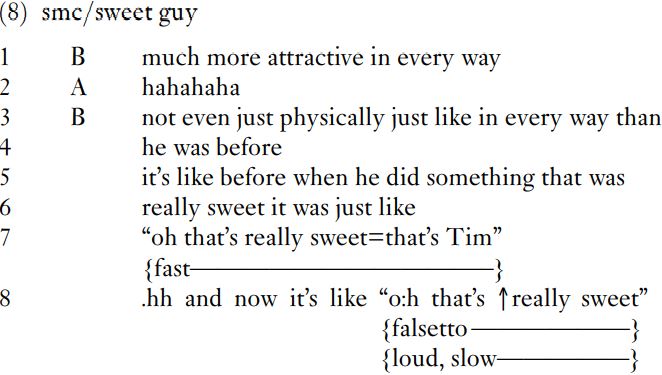


 Grammar
Grammar
 Tenses
Tenses
 Present
Present
 Past
Past
 Future
Future
 Parts Of Speech
Parts Of Speech
 Nouns
Nouns
 Verbs
Verbs
 Adverbs
Adverbs
 Adjectives
Adjectives
 Pronouns
Pronouns
 Pre Position
Pre Position
 Preposition by function
Preposition by function 
 Preposition by construction
Preposition by construction
 Conjunctions
Conjunctions
 Interjections
Interjections
 Grammar Rules
Grammar Rules
 Linguistics
Linguistics
 Semantics
Semantics
 Pragmatics
Pragmatics
 Reading Comprehension
Reading Comprehension|
Read More
Date: 2023-05-31
Date: 2023-12-05
Date: 2023-12-15
|
Falsetto involves the raising of a speaker’s average f0 to way beyond their normal range. To produce falsetto, the vocal folds are stretched and lengthened and the glottis is not completely closed. Falsetto can be used in singing, but also occurs in conversational speech. The IPA has no symbol for marking falsetto.
Here are two cases of falsetto from everyday talk. The first one is part of a complaint from Lesley to her friend Joyce about an acquaintance of theirs, who has offended Lesley. At line 8, she goes into falsetto, probably marking some kind of stance such as ‘outrage’ at the way she has been treated.

The second example is a woman describing to a friend her feelings towards a man. She compares her earlier stance towards him with her current view of him: she is now much more favorably disposed towards him than she was. She uses the same words to express her stance towards him, but the second time round, she speaks in falsetto, as well as speaking much more slowly and loudly.

In both of these examples, by moving into falsetto, the speaker is able to use a higher pitch range than her normal one, which means that the difference between the highest and lowest values of the f0 range is expanded. The high pitches the speakers can reach (as high as 673 Hz in the first example and 572 Hz in the second one) may be used to mark out their current talk as conveying something ‘noteworthy’, or something that the other person is expected to comment on. In both these cases, the speakers are involved in presenting a strong stance towards the person they are talking about: in the first case as part of a complaint, and in the second case as part of a positive, upgraded stance as compared to an earlier one. Perhaps falsetto is used to mark an attitude towards the subject matter which is at one extreme or the other – but not neutral.
|
|
|
|
لخفض ضغط الدم.. دراسة تحدد "تمارين مهمة"
|
|
|
|
|
|
|
طال انتظارها.. ميزة جديدة من "واتساب" تعزز الخصوصية
|
|
|
|
|
|
|
عوائل الشهداء: العتبة العباسية المقدسة سبّاقة في استذكار شهداء العراق عبر فعالياتها وأنشطتها المختلفة
|
|
|